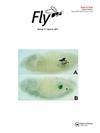Somatic recombination in adult tissues: What is there to learn?
IF 2.4
4区 生物学
Q3 BIOCHEMISTRY & MOLECULAR BIOLOGY
引用次数: 11
Abstract
ABSTRACT Somatic recombination is essential to protect genomes of somatic cells from DNA damage but it also has important clinical implications, as it is a driving force of tumorigenesis leading to inactivation of tumor suppressor genes. Despite this importance, our knowledge about somatic recombination in adult tissues remains very limited. Our recent work, using the Drosophila adult midgut has demonstrated that spontaneous events of mitotic recombination accumulate in aging adult intestinal stem cells and result in frequent loss of heterozygosity (LOH). In this Extra View article, we provide further data supporting long-track chromosome LOH and discuss potential mechanisms involved in the process. In addition, we further discuss relevant questions surrounding somatic recombination and how the mechanisms and factors influencing somatic recombination in adult tissues can be explored using the Drosophila midgut model.成人组织中的体细胞重组:有什么值得学习的?
体细胞重组对于保护体细胞基因组免受DNA损伤至关重要,但它也具有重要的临床意义,因为它是导致肿瘤抑制基因失活的肿瘤发生的驱动力。尽管这很重要,但我们对成人组织中体细胞重组的了解仍然非常有限。我们最近利用果蝇成体中肠的研究表明,有丝分裂重组的自发事件在衰老的成体肠道干细胞中积累,并导致杂合性(LOH)的频繁丧失。在这篇Extra View文章中,我们提供了支持长径染色体LOH的进一步数据,并讨论了参与该过程的潜在机制。此外,我们进一步讨论了体细胞重组的相关问题,以及如何利用果蝇中肠模型探索成体组织中影响体细胞重组的机制和因素。
本文章由计算机程序翻译,如有差异,请以英文原文为准。
求助全文
约1分钟内获得全文
求助全文
来源期刊

Fly
生物-生化与分子生物学
CiteScore
2.90
自引率
0.00%
发文量
17
审稿时长
>12 weeks
期刊介绍:
Fly is the first international peer-reviewed journal to focus on Drosophila research. Fly covers a broad range of biological sub-disciplines, ranging from developmental biology and organogenesis to sensory neurobiology, circadian rhythm and learning and memory, to sex determination, evolutionary biology and speciation. We strive to become the “to go” resource for every researcher working with Drosophila by providing a forum where the specific interests of the Drosophila community can be discussed. With the advance of molecular technologies that enable researchers to manipulate genes and their functions in many other organisms, Fly is now also publishing papers that use other insect model systems used to investigate important biological questions.
Fly offers a variety of papers, including Original Research Articles, Methods and Technical Advances, Brief Communications, Reviews and Meeting Reports. In addition, Fly also features two unconventional types of contributions, Counterpoints and Extra View articles. Counterpoints are opinion pieces that critically discuss controversial papers questioning current paradigms, whether justified or not. Extra View articles, which generally are solicited by Fly editors, provide authors of important forthcoming papers published elsewhere an opportunity to expand on their original findings and discuss the broader impact of their discovery. Extra View authors are strongly encouraged to complement their published observations with additional data not included in the original paper or acquired subsequently.
 求助内容:
求助内容: 应助结果提醒方式:
应助结果提醒方式:


